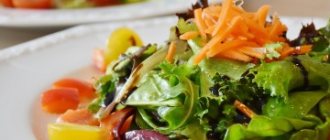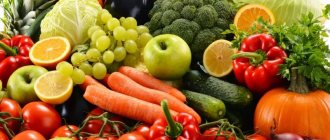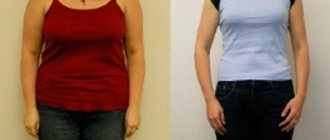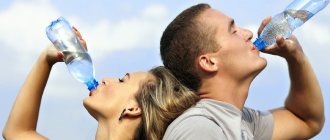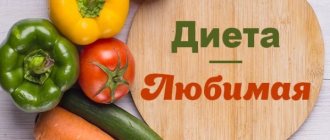The essence and principles of the Atkins diet
Dr. Robin Atkinson, a cardiologist and scientist, developed a diet whose main principle is to reduce carbohydrate intake in the diet. Thanks to his carefully thought-out diet, which lasts two weeks, metabolism accelerates, promoting increased burning of fat due to normalization of metabolism.
According to Atkinson, there is a group of foods that prevent a person from losing weight, and, following this principle, a diet menu has been developed from which these most problematic foods are removed.
According to the doctor, reducing calories does not always lead to weight loss; on the contrary, while on the diet he developed, you will consume more calories than usual, and at the same time lose weight.
Since carbohydrates and muscle tissue are burned first, it is not the turn for fats. Reducing carbohydrates helps maintain oneself in an energetic state by burning fat deposits, which serve as fuel for the body in this case, but muscle fibers are preserved by a large amount of protein in the diet.
In order for the diet to take effect, instead of the usual 300 carbohydrates per day, you should consume no more than forty.
Dr. Atkins' diet is based on three important principles:
- Strengthening metabolic processes by changing the diet. Calories are consumed by the body in order to get rid of fat and digest incoming food.
- The breakdown of fats instead of carbohydrates due to the deficiency of the latter. With insufficient carbohydrate intake, the body rebuilds itself and begins to burn fat reserves.
- Decreased appetite. Insulin surges can cause wild hunger, so the most important principle of the diet is to prevent these surges. In the absence of carbohydrates in the body, sharp insulin surges stop, and the state of hunger is dulled.
Basic rules for being on a diet:
- Strictly follow the algorithm of a specific phase without violating it.
- At the same time, use a vitamin complex, since the diet is not 100 percent balanced.
- Do not neglect sports to speed up the weight loss process.
- Follow the rule of fractional nutrition - eat in small portions and often.
- Avoid feeling hungry. You need to eat as much as necessary to feel full, but without overeating.
- Drink enough water – eight glasses a day.
We advise you to read: How to learn to drink more water - 6 useful tips
The revolutionary Atkins diet is suitable for people:
- those who cannot imagine their life without protein foods;
- with type 1 and type 2 diabetes (according to an individually designed menu);
- those who play sports and want to emphasize their muscle mass;
- young age from twenty to forty years;
- with no vegetarian inclinations;
- those who want to maintain their weight after losing weight by introducing this diet into their life on a regular basis;
- those who know how to plan their day wisely and follow established nutritional rules;
- those who want to get rid of at least ten kilograms;
- active in life, in perpetual motion;
- able to give up sweets and flour;
- without problems with kidneys, heart, liver.
The Atkins diet is a four-step process.
The Atkins diet includes four different phases:
First stage (Introduction)
Up to 20 g of carbohydrates per day for 2 weeks. Eat high-fat, high-protein, low-carb vegetables such as leafy greens. This stage starts weight loss.
Second stage (Balancing)
Slowly add more nuts, low-carb vegetables and small amounts of fruit to your diet.
Third stage (Stabilization)
Occurs when you get very close to your goal weight. Gradually add more carbohydrates to your diet until your weight loss process begins to slow down.
Fourth stage (Maintenance)
Here you can eat as many healthy carbohydrates as your body can handle without gaining the weight back.
However, these steps are a bit complicated and may not be necessary at all. All you need to do is lose weight and keep it off by following the nutrition plan outlined below.
Some people choose to skip the first step entirely and include plenty of vegetables and fruits in their diet from the very beginning. This approach can also be very effective.
Others, on the contrary, prefer to linger at the “Introduction” stage indefinitely. This method is also known as a very low-carb ketogenic diet (keto).
Phases of the Atkins Diet
The Atkins protein diet is a four-phase diet. Each phase has its own duration and diet and is aimed at breaking down the fat layer, as well as maintaining the achieved result.
Induction Phase (Stage #1)
The phase lasts 14 days and is designed to rebuild the body to a new diet, in which carbohydrates are practically absent. At this stage, it is allowed to consume them in quantities not exceeding twenty grams. Alcoholic drinks and coffee are included in the list of prohibited foods, as they cause a strong appetite. Any deviations from the diet instructions will negate all efforts, so you should carefully monitor what you eat.
You can eat at any time convenient for you and even have a snack, but only with approved foods. Under no circumstances should you overeat, but satiety is a must. The menu should be varied and as balanced as possible.
List of products allowed at the first stage:
- all types of meat and meat products without carbohydrates;
- any fish without breadcrumbs;
- poultry cooked without the addition of sauces and breadcrumbs;
- cheeses without carbohydrates or with minimal carbohydrate content;
- seafood without added carbohydrates;
- oils and fats;
- eggs in any form;
- any seasonings without carbohydrates;
- water, teas without sugar, herbal infusions, lemon concentrate;
- green vegetables and herbs.
We advise you to read: Recipes for making ginger tea for weight loss at home
Prohibited use:
- sugar and many sweeteners such as aspartame and fructose;
- flour and pasta and confectionery products;
- vegetables containing starch;
- fruits and juices based on them;
- seeds, nuts;
- alcoholic drinks.
Phase of weight loss to the desired level (stage No. 2)
At the end of the first stage, according to Dr. Atkins, the body must adapt to the new way of eating. At the second stage, everyone must determine for themselves a comfortable rate of carbohydrate consumption per day in order to maintain the achieved result.
Nutrition rules at this stage:
- The increase in carbohydrates should occur slowly and should not exceed five grams in one week. In this case, it is important to track your weight every day at a specific time.
- From the list of prohibited foods, nuts, seeds, fruits, and juices are gradually migrating to your menu. Your diet should be as balanced and healthy as possible. Alcoholic drinks are allowed in small quantities and only with strict control of the carbohydrates they contain.
It is important to remember that any violation of carbohydrate intake takes you back to the first stage.
- Physical activity should be increased in order to speed up the weight loss process. Against the backdrop of a high-quality workout with high calorie expenditure, it becomes possible to increase carbohydrate intake. If the weight stops leaving you, despite all your efforts, you should slow down the process of increasing carbohydrates in your diet.
- Track your well-being . After two months, be sure to take a blood test for all the necessary indicators and, based on the result, decide for yourself, together with your doctor, whether you should continue to lose weight on Dr. Atkins’ diet.
Allowed products during the weight loss stage:
- red bell pepper (½ cup), boiled broccoli 150 grams, cauliflower (full cup), asparagus, spinach, onion in moderation;
- cream with a high percentage of fat, cheeses with a high carbohydrate content;
- nuts and seeds in moderation (you should study the permitted daily intake);
- raspberries, blueberries, strawberries, melon without exceeding the amount specified in the diet;
- lemon and tomato juices in limited quantities.
Phase of gradual transition to weight stabilization (stage No. 3)
At this stage, it is necessary to continue building up carbohydrates at a rate of ten grams per seven days. If the weight rises again, you should return to the second stage. Your daily intake of carbohydrates is determined empirically: the amount per day that does not allow your weight to fluctuate is the ideal figure. Naturally, if a person exercises regularly, he can afford to consume more carbohydrates.
At the third stage, nutrition is also based on the consumption of proteins and fats. Carbohydrates are introduced in the form of a specific product, the body's reaction to which is tested. Thus, those foods that cause water retention, weight gain or increased appetite are eliminated.
We advise you to read: How to quickly remove water from the body and lose weight
The following products are added to the list of permitted products:
- vegetables containing starch in regulated quantities;
- nuts such as cashews, peanuts, pecans, walnuts, pine and sesame seeds, pumpkins in the permitted quantity;
- beans and lentils, ¼ cup each;
- cherries, grapes, strawberries and other fruits and berries, the dosage of which is limited per day;
- rice, barley, oatmeal ¼ cup each and a piece of bread.
The third stage helps to reach the desired weight, and when the goal is achieved, you can move on to stage No. 4.
Weight maintenance phase (stage #4)
Following the rules of the fourth stage will help you maintain the result that you have achieved with such persistence. You can maintain weight throughout your life, being in this phase permanently, since by the end of the third stage you come to proper nutrition, because your body has already adapted and is comfortable.
Your weight should not fluctuate by more than three kilograms, but if this happens, you can return to the previous phase to regain your ideal weight. Apart from this, try to always exercise as this will help you to maintain a fit body without any difficulty.
What does the concept of proper nutrition include?
- You should be very careful when choosing foods, consuming the most healthy and vitamin-rich substances.
- Naturally, your diet should be dominated by proteins and fats. It is important to get carbohydrates from equally healthy foods, such as nuts, seeds, milk products, various grains, vegetables, fruits, etc.
- Any water-retaining carbohydrate foods should be excluded from your diet.
- Well, no matter how hard we try to get all the necessary vitamins and minerals from foods, this is not always possible, so do not forget to take courses of vitamins or dietary supplements.
Sample menu for the day
| Morning meal | Three eggs in an omelet + a piece of lightly salted red fish + unsweetened tea/coffee. |
| Lunch | Natural yogurt without additives with a low fat content + rolled oats (2 tbsp. spoons). |
| Lunch time | Boiled meat. |
| Afternoon snack | A fish dish. |
| Dinner | Fish steak prepared in a dietary manner + a glass of low-fat kefir + natural yogurt without additives. |
Sample menu for the first stage
Now we will show you what the approximate menu should be for the first two weeks of the diet. As for diversity, there will be no problems with it. After all, here you can find the simplest dishes for the lazy, and delicious recipes for those who like to spend a lot of time in the kitchen.
The first day
Morning : scrambled eggs with two eggs in butter + a thin slice of bacon + black tea. Snack : 300g vegetable salad of cucumbers and tomatoes. Lunch : half a chicken breast + fried mushrooms (champignons, chanterelles, oyster mushrooms) Evening : trout or salmon steak, sprinkled with lemon juice.
Low Carb Foods
Second day
Morning : a hearty portion of cottage cheese with milk + green tea. Snack : 1 grapefruit. Lunch : fish soup 400g without potatoes + 1 hard-boiled egg. Evening : 100g boiled broccoli + 2 pieces of chicken roll with herbs.
Day three
Morning : 2 scrambled eggs with spinach + coffee without sugar. Snack : 150g low-calorie yoghurt. Lunch : leftover chicken roll from dinner + a glass of kefir. Evening : salad with crab sticks and avocado + green tea.
Interesting: Mediterranean diet: menu for the week
Day four
Morning : pancakes with maple syrup without sugar + coffee or tea. Snack : hard cheese 20g + glass of milk. Lunch : chicken soup + 300g vegetable salad. Evening : peppers stuffed with lean minced meat - 2 pcs.
Day five
Morning: baked apples with green tea without sugar. Snack : half a boiled breast. Lunch: beef stew + 1 orange. Evening : fried raba with herbs.
Day six
Morning : 2 sausages + black tea with lemon. Snack : fried mushrooms. Lunch : cottage cheese casserole + a small piece of chicken fillet. Evening : salad with shrimp + 150g chicken.
Day seven
Morning : 3 small cheesecakes with tea or coffee. Snack : natural low-calorie yogurt 150g Lunch: chicken puree soup 300g. Evening : baked beef with cheese and mushrooms.
Day eight
Morning: 1 sausage + 1 boiled egg + tea. Snack : glass of fermented baked milk 200g. Lunch : chicken cutlets with 100g of stewed vegetables. Evening : fish casserole without potatoes.
Day nine
Morning: scrambled eggs with cheese + coffee. Snack : 250g of cucumber, tomato and leek salad. Lunch : lean pork chops + glass of water with lemon juice. Evening : 2 fish cutlets + fried eggplants 80g.
Day ten
Morning: a glass of kefir + 1/2 apple. Snack : half a boiled breast. Lunch : white fish fried in batter + 3 lettuce leaves. Evening : chicken roll with herbs 2 pieces + a handful of nuts.
Interesting: Low-carb diet for weight loss
Day eleven
Morning : cottage cheese casserole 180g + a glass of lemon juice. Snack : a slice of dietary ham + 2 small fresh cucumbers. Lunch : cutlets made from lean minced meat. Evening : seafood salad + steamed veal.
Day twelve
Morning: two sausages + a glass of milk. Snack: one grapefruit. Lunch : fish soup without potatoes + 1 egg. Dinner : meatballs with a minimum amount of rice.
Day thirteen
Morning : protein omelet + black tea with lemon. Snack: hard cheese 25g + a glass of kefir or fermented baked milk. Lunch : steamed chicken leg + 80g fried eggplant. Dinner : stewed trout steak + green tea.
Day fourteen
Morning : 3 cheesecakes + a glass of milk. Snack: 150g omelette with herbs. Lunch : julienne with mushrooms and cheese + water with lemon juice. Dinner : chicken chops with sour cream and cheese + a handful of walnuts.
What's great about the Atkins diet is that it's filling. And the 14-day menu that we posted above proves this. And also before and after photos, where completely different people demonstrate truly excellent results!
What do you think about protein diets?
Menu for 14 days
| Day | Morning meal | Lunch time | Afternoon snack | Last meal |
| 1 | — whites (2 pcs.) + yolk in the form of an omelette; - a piece of sausage. | - turkey breast, cooked in the oven. | - vegetable salad seasoned with sour cream (100 grams). | — stewed beef with vegetables (100 grams). |
| 2 | - a piece of ham; - a piece of cheese; — fresh cucumbers (2 pcs.); - whole grain bread. | — cream soup and pumpkin seeds. | — fermented baked milk (0.2 liters). | - trout in steak; — vegetable salad (150 grams). |
| 3 | - cottage cheese + peach fruit. | - baked turkey meat. | - natural yogurt. | - white fish meat cooked in an air fryer. |
| 4 | — chicken eggs (2 pcs.); - a piece of sausage; - a piece of cheese. | - minced pork cutlets; - vegetable stew (100 grams). | - tuna sandwich on whole grain bread. | - eggplant baked in the oven. |
| 5 | - cottage cheese casserole. | - turkey thigh; - vegetable stew. | - boiled eggs (two pieces); - cucumber; - leaf salad. | — dolma in grape leaves (6 pieces) or stuffed peppers (2 pieces). |
| 6 | - two-egg omelette; - turkey breast. | - pumpkin milk porridge. | — natural yogurt (200 ml); - chicken egg. | - beef with vegetables (150 grams). |
| 7 | - cottage cheese + banana. | — white fish soup + salad with vegetables (0.2 kg). | — fermented milk natural product of any fat content. | - trout cooked in a convection oven or oven. |
| 8 | - kefir (200 ml); — muesli (6 tablespoons). | - borscht with pork. | - trout; - a piece of cheese; - green tea. | - two cabbage rolls. |
| 9 | - egg white omelette with bacon; - a couple of cucumbers. | - chicken soup with vegetables. | - curdled milk (200 ml). | - beef with vegetables (200 grams). |
| 10 | — muesli (40 grams); - kefir (200 ml). | - cheese soup without starchy vegetables; - tomatoes (2 pcs.). | - cottage cheese with two dried apricots. | - chicken cooked in any way with cheese. |
| 11 | - 0.2 kg of vegetable salad. | - baked meat with cheese. | - any drinking fermented milk product without additives. | - fish cutlets with cottage cheese. |
| 12 | - cottage cheese with dried fruits and sour cream. | - baked vegetables and turkey fillet. | - coffee with cheese. | - turkey cutlets with beans. |
| 13 | - egg and vegetable salad (100 grams). | - fish soup. | - fruit of your choice. | - fatty fish cooked in the oven with sauce. |
| 14 | - egg white omelet with herbs. | - chicken soup with vegetables. | - vegetable salad (0.2 kg) | - chicken fillet, cooked in the oven or steamed. |
Atkins diet: menu for one week
An approximate table of the Atkins diet for the induction phase without weight and portion size:
| Days of the week | Breakfast | Dinner | Dinner |
| Monday | Protein omelet from two chicken eggs, a slice of ham | Chicken salad with olive oil and nuts | Stewed cabbage with meat |
| Tuesday | Boiled egg white with fish | Vegetable soup with steam cutlet | Vegetable stew with veal |
| Wednesday | Cottage cheese with sour cream | Fish baked in foil | Chicken chops with sour cream |
| Thursday | Quail egg omelette | Turkey fillet with spices | Stuffed pepper |
| Friday | A glass of kefir and muesli | Chicken breast baked in the oven with spices | Sea or river fish in batter |
| Saturday | Egg omelet with a piece of chicken | Borscht with a piece of pork | Vegetable stew with beef |
| Sunday | Omelette with vegetables | Fish soup | A glass of kefir |
Atkins Diet Recipes
| Name of dish | Ingredients and dosages | Cooking method |
| Tongue casserole | - 0.4 kg of boiled tongue; - 0.2 kg of chopped mushrooms; - 150 grams of sour cream; - a head of chopped onion; - 0.2 kg parmesan; - herbs and spices to taste. | Cut the meat into small rectangular pieces. Fry mushrooms with onions, add pieces of tongue, spices, and herbs. Place the resulting mixture in a special baking dish for baking in the oven. Bake for twenty-five minutes. Three minutes before it's ready, sprinkle the casserole with grated Parmesan. |
| Omelette with sausages and vegetables | - four eggs; - one tomato; - some Brussels sprouts; - ½ onion; - some beans in pods; - a couple of sausages; - 0.1 kg of grated parmesan; - spices and herbs to taste. | Cut the sausages into slices and fry them with vegetables. When they are almost ready, add the eggs. Sprinkle with Parmesan, spices, herbs and bring to readiness. |
| Egg and shrimp salad | — 0.2 kg of boiled shrimp; - lettuce leaves; - a pair of chicken eggs; - 3 tbsp. spoons of olive oil; - 30 grams of vinegar; - 30 grams of lemon concentrate; - 5 grams of mustard; - salt to taste. | Process the lettuce leaves, cut them and place them on the bottom of a salad dish, place eggs and seafood on top. Prepare salad sauce from the remaining ingredients and mix well. Season the salad with the sauce. |
Atkins diet menu for 2 weeks (14 days)
The Atkins diet food table also makes it easy to create a menu for 2 weeks.
The first 7 days can be based on the option presented above; the remaining days can be varied as follows.
So in the morning of the 1st day of the second week you can enjoy bacon and eggs , chicken wings for lunch, a salad with sour cream sauce will decorate the afternoon snack, and the day will end with meat in eggplant rolls.
On day 2, you can prepare sliced cheese, ham and cucumber slices , pumpkin soup, drink kefir for an afternoon snack, and dinner will be salmon on the grill.
Day 3 will give you cottage cheese mixed with apples, chicken breast cooked in a slow cooker, a low-fat version of yogurt, and flounder with onions.
The morning of the 4th day can begin with cooking poached eggs , for lunch you can snack on soft meat cutlets, a cheese plate with tea will dilute the afternoon snack, and zucchini with garlic sauce will complete the day.
The first 7 days can be based on the option presented above; the remaining days can be varied as follows.
lift your mood in the morning of the 5th day ; for lunch you can make grilled chicken; eggs for an afternoon snack and bell peppers with mushrooms will complete the day.
Day 6 - scrambled eggs with green onions, assorted vegetables with stewed meat, natural yogurt, pumpkin porridge.
To spend the 7th day of the second week and celebrate the end of the diet in 14 days, you can pamper yourself by preparing shakshuka eggs without sugar , fried ribs with a vegetable side dish, drinking a glass of low-fat kefir for an afternoon snack and making a dinner of sole under a cheese net.
Advantages and disadvantages of the Atkins diet
The benefits of the diet include:
- quickly getting rid of extra pounds, stimulating you to continue your diet;
- achieving healthy levels of cholesterol, triglycerides and glucose;
- no difficulty in calculating the amount of food consumed;
- comfortable being on a diet due to the absence of hunger, since the diet menu contains foods that promote complete satiety;
- lightness in the stomach and increased brain activity;
- the ability to choose your individual carbohydrate intake.
Disadvantages of the diet:
- the likelihood of an increase in cholesterol in the body, which is bad for it, which can cause heart disease;
- refusal of fruits and some vegetables deprives the body of the necessary fiber for the normal functioning of the digestive system, as well as antioxidants, which are assistants in the fight against cancer cells;
- increased protein consumption can lead to gastrointestinal diseases;
- a mandatory regime of daily counting of the amount of carbohydrates eaten, violation of which returns you to the previous stage of the diet;
- unbalanced diet, requiring additional intake of vitamin and mineral complexes.
Contraindications
The low-carbohydrate Atkins diet has its contraindications, identified on the basis of repeated studies:
- mental illness;
- kidney diseases, liver problems;
- disruption of the gastrointestinal tract;
- weakening of the immune system;
- postoperative recovery period;
- enhanced training regimen at a professional level;
- unstable hormonal levels;
- old age.
The presence of diabetes and heart disease is a good reason for prior consultation with your doctor.
